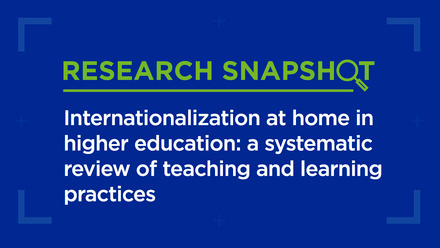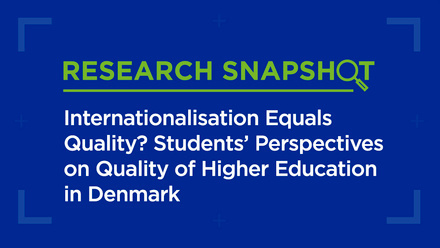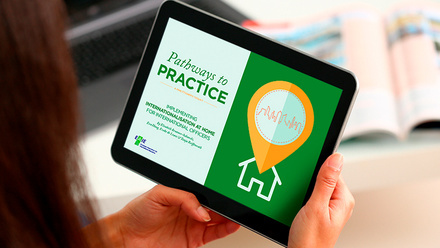Internationalisation at home: past, present and future

It has now been 20 years since Internationalisation at Home was introduced, with the aim of bringing the benefits of internationalisation to all students beyond just the mobile few. As physical student mobility is still limited to a small minority of students, this aim is as valid today as it was 20 years ago.
However, many aspects of the concept have changed over time. One of these is the terminology with which Internationalisation at Home is framed – we would now call it an ‘inclusive’ form of internationalisation. We have also witnessed new arguments for Internationalisation at Home: the latest is that it can serve to reduce the carbon footprint of student mobility, which is now being calculated as equivalent to that of countries such as Croatia or Tunisia.
Some aspects of Internationalisation at Home have not changed, and those are the misconceptions with which it is surrounded. Many still consider Internationalisation at Home to be an alternative to student mobility. Yet, we know very well that the vast majority of students depends on this ‘alternative’ and only a small minority makes up the ‘norm’. We should therefore change our thinking and consider an internationalised curriculum the basis for all students, with some students extending this through international mobility. Some other misconceptions we still encounter after 20 years include that Internationalisation at Home equals teaching in English, or that hosting international students is necessary in order to be able to internationalise teaching and learning.
Same goal, different approaches
It is now generally accepted that an internationalised home curriculum is not an aim in itself, but rather an instrument to enhance the transversal skills of graduates for the workplace. Among these skills are communication, problem solving, critical thinking and understanding the ethical dimensions of the profession. In addition to the development of transversal (or employability) skills, internationalisation of the home curriculum is also considered a way to prepare students not only for their role as responsible professionals but also as global citizens. This strand in the internationalisation discourse is characterised by movements such as ‘internationalisation in higher education for society’ and also stresses the role that a university has as an international agent in its own local community. A recent component in the discourse is how an internationalised home curriculum can contribute to Streamlining sustainability within the university .
We should consider an internationalised curriculum the basis for all students, with some extending this through international mobility
There are also changes in the available instruments for Internationalisation at Home. Traditional elements such as literature and cases from different contexts, local and international guest lecturers and engagement with local cultures all remain relevant, but new opportunities have also emerged through technology. This enables online collaboration between students ‘at home’, for example through COIL: what’s in an acronym? (COIL). However, whether and how online collaboration contributes to students’ learning depends on educational design rather than on technology. While technology has made new forms of learning at home or rather in a ‘third space’ possible, it also leads to new challenges. These may result in disruptions, such as deepfakes and interference in elections, with potentially far reaching consequences that universities want to address and prepare their graduates for. Therefore, universities now foster the notion of critical world citizenship which has students reflect more consciously and critically on the impact of their actions, locally and globally.
Instigating change
All this implies that Internationalisation at Home is not static. It changes along with developments in society and economy. Implementing it is a demanding task for lecturers, the key actors in Internationalisation at Home. Curriculum internationalisation: a process of change is impossible without engaging the lecturers. They are familiar with trends in the field and can tell which current and future developments will shape the future of graduates. Ultimately, they are the only ones who can build a meaningful version of internationalisation that is specific to their own discipline. Yet they have often not been prepared for internationalising teaching and learning. Support from educational developers, who are often not participating in the internationalisation process, is lacking and many universities do not have a curriculum design culture that includes internationalisation.
A good strategy for Internationalisation at Home acknowledges the role of many stakeholders in Internationalisation at Home across the institution. These are not only students and lecturers. Leaders, through their top-down policies, should stimulate bottom-up development in programmes of study. Managers, teaching and learning centres, curriculum committees, policymakers and quality assurance officers can all contribute to creating the circumstances that enable lecturers to assume ownership of the international and intercultural dimensions of learning.
Internationalising a curriculum is impossible without engaging the lecturers
In many cases, Internationalisation at Home ends up in the international office, where it does not belong, as the international office cannot be responsible for teaching and learning. Yet the international office, as well as policy advisors, can play a decisive role in ‘giving internationalisation back to academics’. They can create the circumstances, for example by initiating professional development that focuses on internationalising learning outcomes and assessment as well as training for specific aspects as designing collaborative online spaces.






